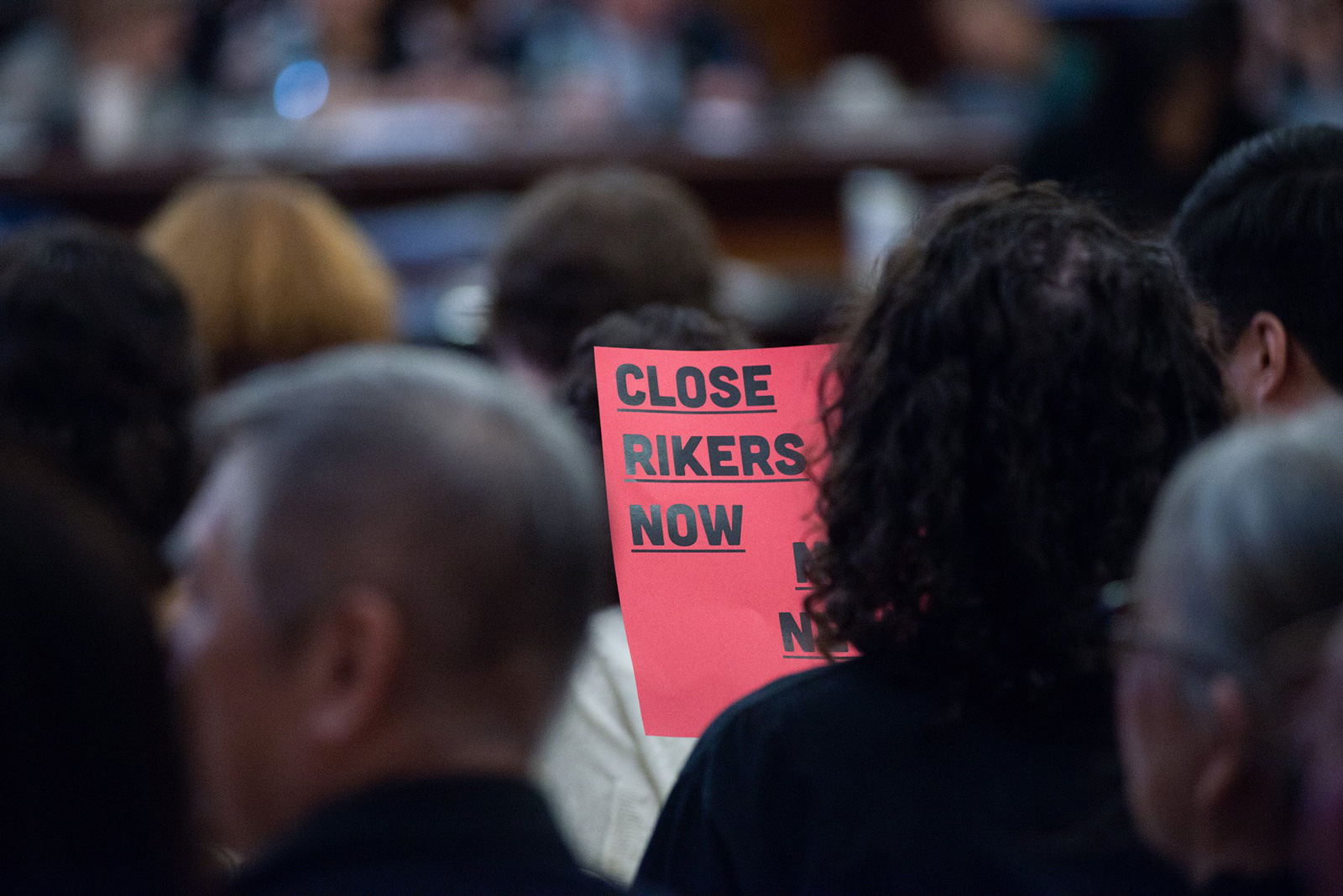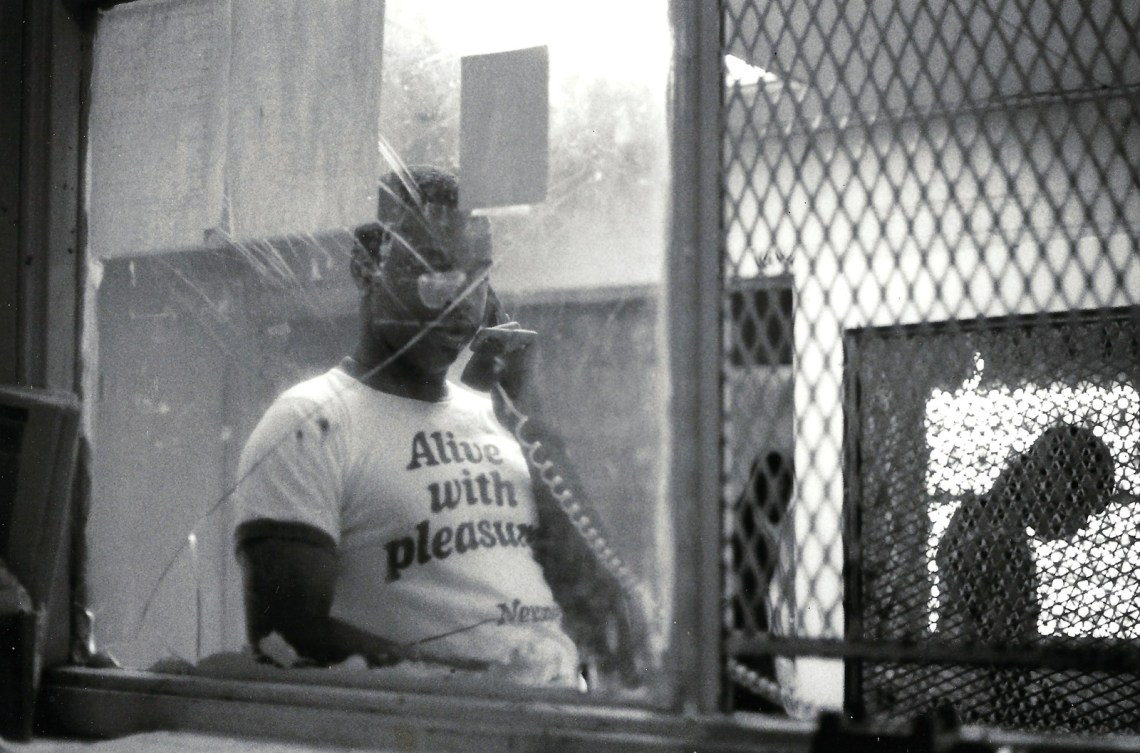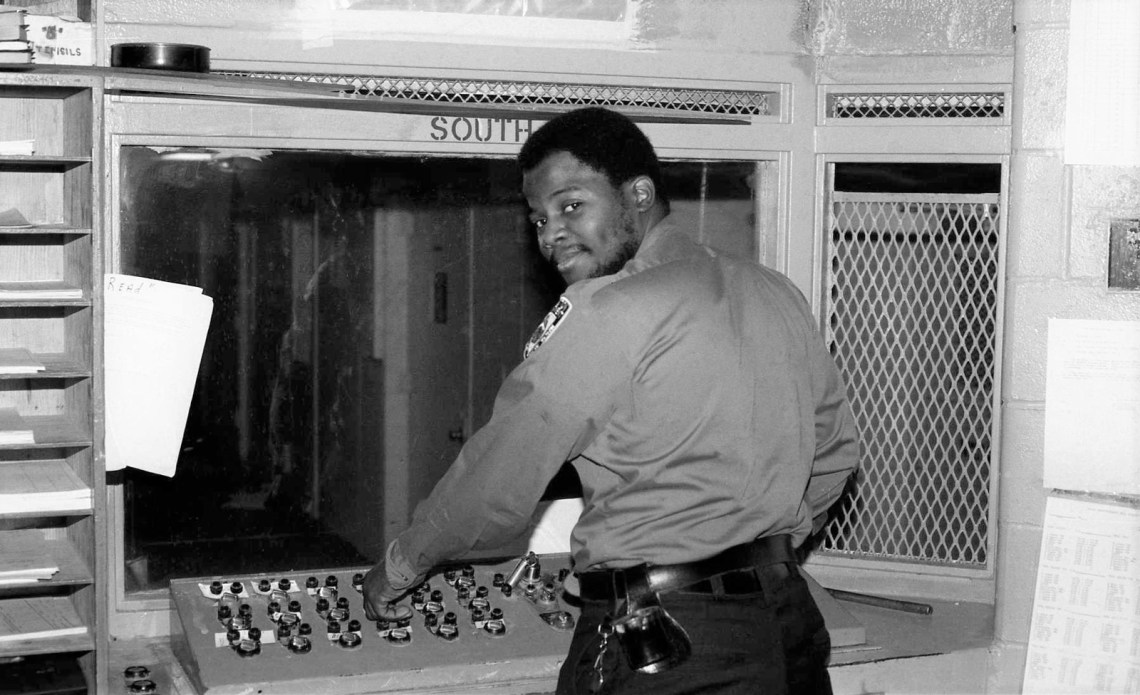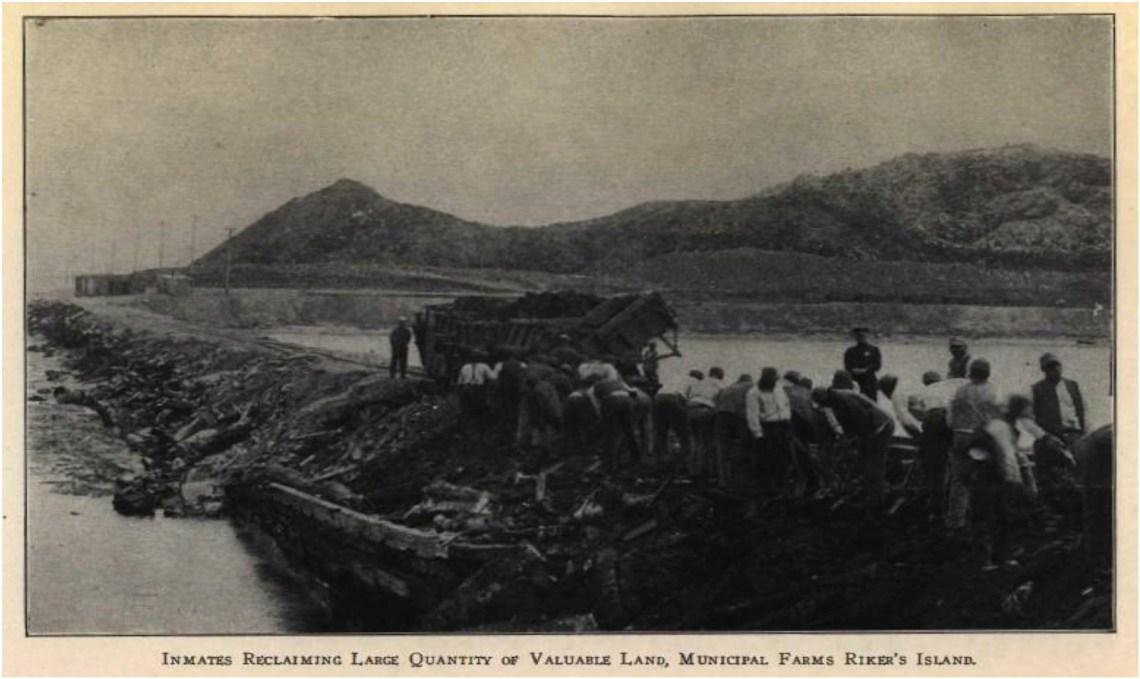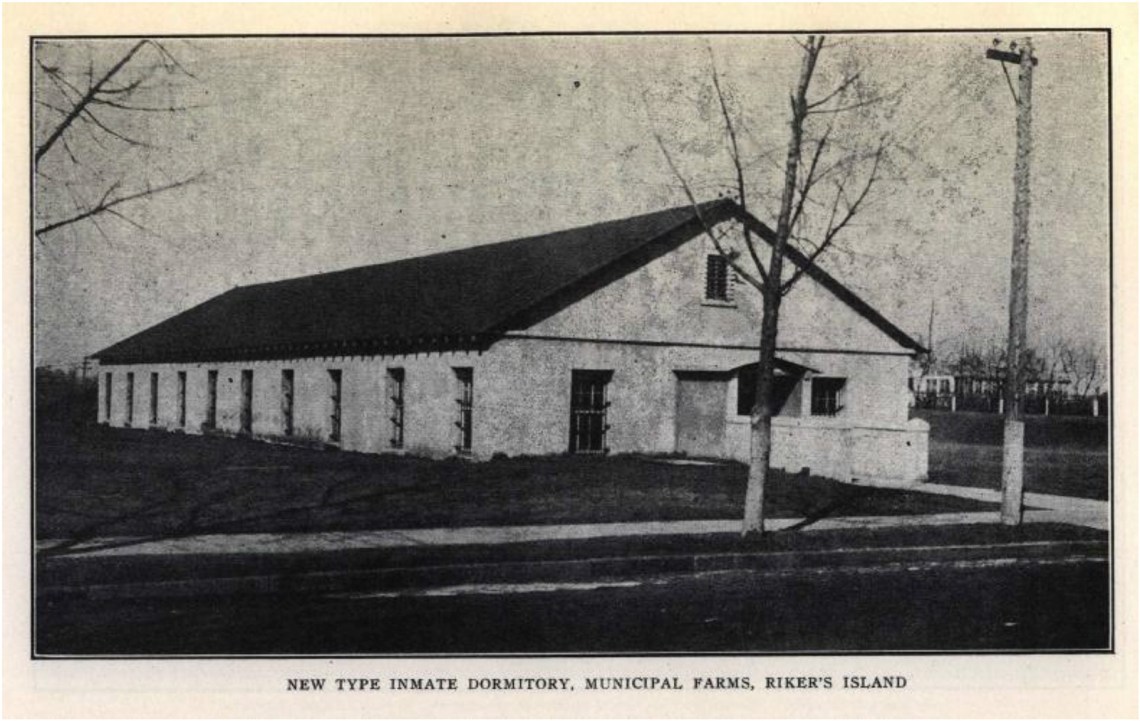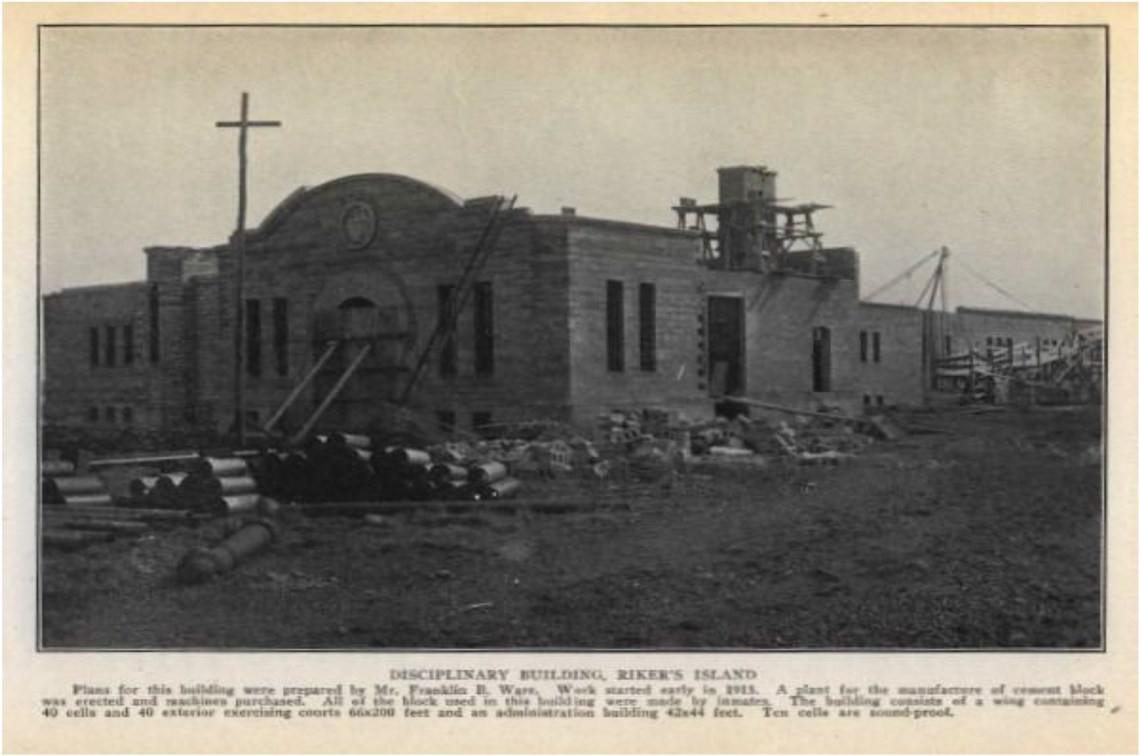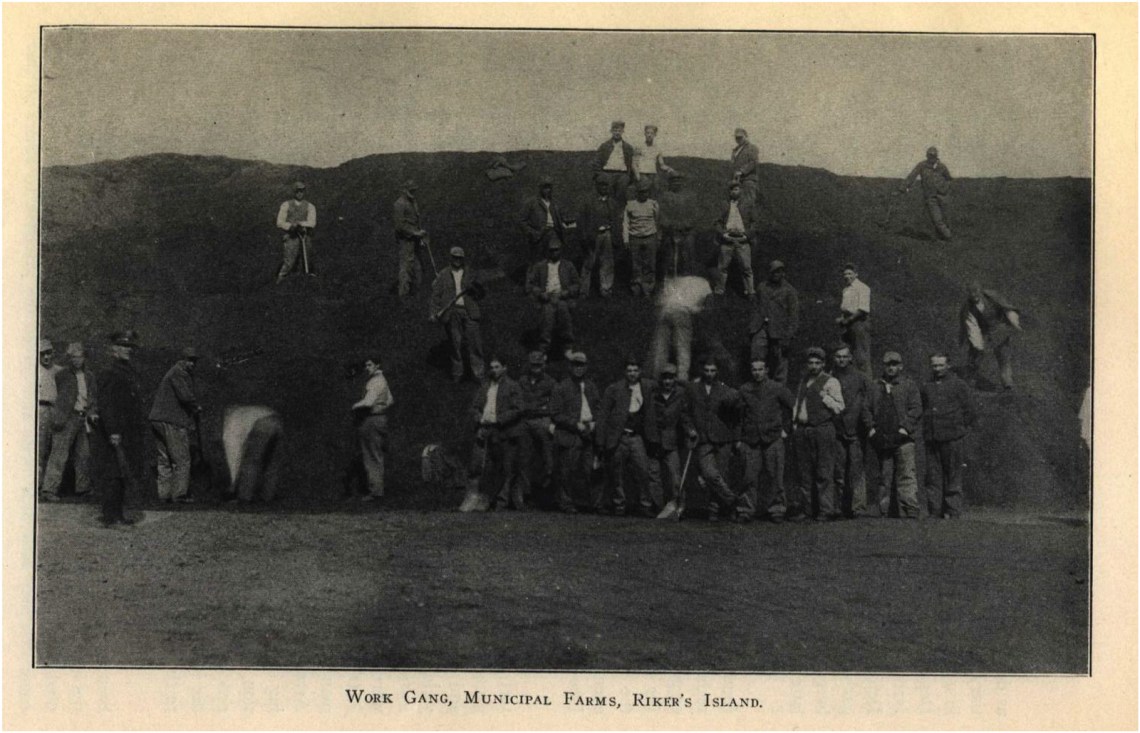On September 5, a New York City Council hearing on the building of four borough-based jails tied to the closure of the Rikers Island Jail complex ran for ten hours of passionate and combative testimony from members of the public. Usually a subdued process, this particular Uniform Land Use Review Procedure—an arcane process for analyzing proposals that require changes to zoning regulations, and that generally sticks to matters like floor area ratio, environmental impact, and shadows cast by tall buildings—involved debates about hot-button criminal justice issues such as supervised release, bail reform, and alternatives to incarceration. The normal policy against raucous applause or jeering was overrun by passionate activists, some of whom were ejected for yelling at speakers. More than two hundred people stood in a line that snaked around City Hall Park, hoping for access to the meeting.
One speaker, to audible gasps from the audience, chided the chair of the council for inattention and urged the council members to risk their “tidy meaningless careers” to vote against the plan for borough jails—or they would “have blood on their hands.” The main target, however, of speaker after speaker—from those giving testimony to some elected representatives on the council itself—was the New York City mayor’s office, which was reprimanded for a lack of transparency and community engagement while developing its plan to replace Rikers, notorious for its brutal conditions, with the four local jails.
Three years ago, the speaker of City Council, Melissa Mark Viverito, announced the formation of an independent commission to investigate the closure of Rikers. New York City had seen a consistently downward trend in major crime—a reduction by 78 percent since 1993—and the city’s average daily jail population had fallen by 91 percent since 1991. A few months after the speaker’s address, the City Council also passed the Criminal Justice Reform Act, diverting a number of offenses—such as drinking alcohol from open containers, littering, and public urination—from criminal to civil court. These new measures alone led to a 90 percent drop in criminal court summonses.
At the same time, increasing use of pretrial supervised release began to direct thousands of people away from the jails, and alternatives to custodial sentencing programs and bail reform—including online payments and access to bail funds—chipped away at the numbers even more. Amid this wave of reform, and thanks to the efforts of formerly incarcerated activists and criminal justice movements, the independent commission met to assess the state of Rikers and examine ways it could be closed.
A former chief judge of the New York Court of Appeals, Jonathan Lippman, was appointed to lead the commission, which selected twenty-seven commissioners to the task. One was from the Vera Institute, which works for criminal justice reform. Insha Rahman, also from the Vera Institute and a member of the supporting staff for the commission, told me that, at first, the closure of Rikers was not a foregone conclusion. But after a year of research and consultations, the commission concluded that there was still significant potential to reduce the number of people in jail and that closing Rikers would be in the city’s best interest.
Mayor Bill de Blasio, perhaps eager to regain his progressive bona fides after declaring the idea of closing Rikers “unrealistic,” announced on March 31, 2017, that the city aimed to close the complex, working broadly from the commission’s recommendations, and would build four new borough-based jails in its place. The mayor’s office then began the ULURP process—the September 5 hearing represented the last stage of that, following advisory reviews with the community boards, borough presidents, and the city planning commission.
Only a few at the hearing contested the need to close Rikers, though many hoped to avoid jail construction in their neighborhoods. Although some activists highlighted the urgency to support the plan now, and others opposed any plan that required the building of new jails, they shared a frustration that the land use review process represented the first truly open opportunity for public comment on the plan. Worse, the narrow remit of the hearing limited discussion to land use issues and stymied debate on criminal justice concerns. The activists argued that communities should have been consulted earlier about the plan that City Council will vote on later this month. “You do understand community input is [supposed to come] before you make the decision,” Council member Rafael Salamanca, said to the delegation from the mayor’s office.
With the future of New York City’s correctional system at stake, the overwhelming feeling among activists and community members—amid the kaleidoscope of arguments and the city’s unyielding responses at the early September hearing, and in previous borough meetings—is disappointment and frustration. At this moment in the country’s history, an unusual alignment has taken shape—of investment in and activism around criminal justice reform; widespread recognition of the failure of systems currently in place; political will from all levels of government; and an abundance of successful programs for change backed by policy research. Yet the de Blasio administration is still hiding behind logistics and bureaucracy, repeating past mistakes and reluctant to do more to address its part in the perpetuation of an unjust system. The debates about the closure of Rikers have revealed how the city, circumscribed by what it feels it can get away with politically, is unwilling to look beyond what seems acceptable to what might be possible.
Advertisement
*
Though out of sight and out of mind for most New Yorkers, the Rikers Island complex has long been criticized for a history of brutality and violence disproportionally affecting the city’s black and brown communities—a fact highlighted most recently by the death while in solitary confinement of a transgender woman, Layleen Polanco, because of medical neglect. As of two weeks ago, by the city’s count, there were approximately 7,000 people held across all of New York City’s jails, the majority of whom were at Rikers, at the cost of two billion a year, or around $300,000 per inmate. About 55 percent of the city’s incarcerated are black and 33 percent Latinx, even though only 24 percent of the city is black and 29 percent Latinx. Nearly half of the inmates have some form of mental health issue.
The history of Rikers itself is a warning about putting the onus of reform on infrastructure rather than the systems that lead to incarceration in the first place. Rikers was built in the early 1900s, using the forced labor of largely black and immigrant prisoners, as the modern alternative to the city’s overcrowded and dilapidated facilities on Blackwell’s (now Roosevelt) Island. A September 1886 report in The New York Times mentioned the city’s purchase of the island to allow for “an enormous model penitentiary, ample in size to serve for many years to come and which in all its plans and parts should be the most perfect prison in the world.”
In the mid 1950s, a former judge and criminal justice reformer named Anna M. Kross became the commissioner of the city’s Department of Correction and spearheaded the building of more facilities on Rikers, bringing in social workers and clinicians for rehabilitation of inmates and establishing Rikers as the central facility in the department’s citywide operation. This expansion and consolidation would make Rikers the largest jail complex in the country: by the 1970s, the average daily population began ballooning, eventually reaching a peak of about 21,000 in 1991. At the same time, overcrowding and deteriorating conditions in the jail led to increasing clashes among inmates and between inmates and guards. The nine jails of the complex have become notorious for their brutality despite numerous attempts to address its culture of violence.
In the last decade, a sustained assault from writers and academics like Michelle Alexander (The New Jim Crow, 2010) and James Forman (Locking Up Our Own, 2017) and filmmakers like Ava DuVernay (13th, 2016 and When They See Us, 2019) have brought renewed scrutiny to the racialized and unjust nature of mass incarceration. This has complemented the turn, on the part of lawmakers across the country, toward jail and prison reform on all levels—so much so that even Donald Trump can claim the badge of a reformer after championing the reduction of mandatory minimums and crack sentences in the federal First Step Act.
In July of 2014, a New York Times investigation detailed the scale of the problem—in particular, the “overwhelming brunt of the violence” borne by inmates with mental illness. A month later, the Manhattan US Attorney’s office released an eighty-page report describing the use of excessive force by correction officers on teenagers held at Rikers. The following year, city officials agreed to federal oversight of the complex, the result of a legal settlement from a 2011 class action lawsuit against the city by the Legal Aid Society and the US Attorney for the Southern District of New York, among others. Then, in 2016, the Lippman Commission concluded that Rikers was beyond reform—and made what seemed at the time the radical recommendation that the city should tear it down and replace it with five borough-based jails. Finally, last year, the New York State Commission of Correction underscored Rikers’ failure by including the jail complex in its “Worst Offenders” list of facilities requiring state monitoring.
Advertisement
For all the litigation and official reports, it was perhaps the story of Kalief Browder’s suicide in 2015 that stoked public outrage and sealed Rikers’s fate. Browder was a young man who had been held on the island, unable to make bail, for three years, much of that time in solitary confinement; suffering from depression, and paranoia after his release in 2013, he died two years later. Browder’s story thrust Rikers’s harsh conditions back into mainstream consciousness, making it a place that could no longer be ignored.
Facing unrelenting pressures from activists, the mayor’s office of criminal justice put out its own plan to replace Rikers with not five, but four jails—one in each borough, minus Staten Island. (There are currently eight operating jails on Rikers and three others across the city.) The mayor’s plan—which calls for the rebuilding of existing jails in Manhattan and Brooklyn, the return to service of an inactive one in Queens, and the construction of a new one in the Bronx, at a cost of $8.7 billion—argues that historic reductions of crime in the city and the reduced average daily population in city jails would allow the city to aim to cut the incarcerated population by more than a half by 2026, with an additional combination of reforms of bail and pre-trial detention. The mayor’s office also maintained that better infrastructure would allow officers a wider view of cells and that more sunlight, improved training of staff, and programming available for detainees, like job reentry preparation, would lead to safer jails than those on Rikers.
The morning Mayor DeBlasio first announced the plans for closure was a big day for activists, many of whom have been advocating for decades for the closing of Rikers. “Dozens of us came out,” said Darren Mack, an organizer since 2016 with the criminal justice organization JustLeadershipUSA’s #CLOSErikers campaign. “It was surprising and it was a joy. If it came to demolishing that facility right now, I would stand next to them with a sledge-hammer.” Though a year behind, this represented a major step in the right direction for the city.
Over the last few years, Mack has dutifully attended events in connection to closing Rikers all around the city, sharing his story as a testimony to why Rikers is beyond reform and in urgent need of closure. At the land use review hearing, he spoke about how far organizing efforts to shut down Rikers had come—until recently, he said, it would have been a contentious suggestion.
In 1992, aged seventeen, Mack was arrested as an accomplice to his older brother in a robbery. He received a sentence of twenty-to-forty years, and spent nineteen months on Rikers. There, he read Malcolm X, George Jackson, and Michel Foucault, as well as Thomas Sugrue’s The Origins of the Urban Crisis. Mack was released on parole in 2012, but it was hearing about Browder that became the catalyst for his activism. He learned that Browder’s brother, Akeem, was involved in the movement to close Rikers, and Mack joined. “I was burning with rage, that the same old shit was still happening,” Mack told me. “I wonder how many other Kalief Browders existed.”
In the three years since he was protesting outside the mayor’s Park Slope YMCA gym, Mack and the #CLOSErikers campaign find themselves supporting the mayor’s plan, arguing for the urgent need to close Rikers above all else, even as they demand more reforms and a smaller target jail population from the city. This process to close Rikers had gone “further than we have ever imagined,” the Vera Institute’s Rahman said at the hearing, and “voting yes… is not at odds with striving for a day when jails become obsolete.”
From almost every perspective, there are still disturbing facets of the mayor’s plan. Several council members said at the hearing that they would not be prepared to vote on the plan until there were more concrete commitments to criminal justice reform. Others asked for the building assessments to be redone and the size reduced to reflect the expectation that there will be an even smaller number of inmates than was anticipated at the plan’s inception. Rahman suggested that as the city invests in new jails, it ought to make a corresponding investment in the communities affected—for instance, for “every dollar spent on jail, a dollar in a community that has been impacted. In housing, education, health, green spaces.” Activists who oppose the building of any borough jails argue that the new construction undermines the value of closing Rikers by evading the real systemic issues. And the city’s decision to put four buildings into one land use process, rather than addressing one at a time, is seen by some as an act of bad faith—prioritizing speed to circumvent public critique. The lack of initiative in pursuing community input, especially on points supported by members of the independent commission, is alarming.
Few disagree with the need to close Rikers, but most neighborhood associations have disagreed with the mayor’s plan for reasons other than criminal justice reform. Members of Chung Pak, an organization that manages real estate in Chinatown, where the Manhattan borough jail would be built, have expressed concerns about the effects that construction would have on nearby retail spaces and senior citizen residences. In downtown Brooklyn and Kew Gardens, Queens, community members have complained of inadequate consultation before the locations and plans were finalized. Indeed, the city appointed the panels of its Neighborhood Advisory Councils, which could only make recommendations and were conducted behind closed doors. None of the community boards representing the areas where the jails would be built have approved the plans.
Baffling to many at the land use review hearing, the city plans to rehouse inmates from the existing borough-based jails in Rikers itself during the new construction in the boroughs. This would keep the complex in use for the decade it would take to build the new jails. The Bronx’s Mott Haven neighborhood association and borough president have pushed back against the city’s chosen location for the jail, arguing that it is not close to a court—as the commission recommended—and that it goes against the community’s plans for rehabilitation after decades of neglect from the city. The city’s response has been that it can provide 235 units of affordable housing adjacent to the jail. Questions also came up about how increased traffic from visitors and correction officers—many of whom live outside the city—would effect local residents and businesses.
For many criminal justice reform activists and some council members, however, these are peripheral issues. “This is about the whole entire city,” Mack said, “it is bigger than just one community.”
*
The central challenge involved in closing Rikers Island is reducing the complex’s jail population to a number that can be safely and effectively accommodated elsewhere. And while it might not appear that way, the number of people we keep in jail is almost entirely up to us as a city. As Elizabeth Glazer, the director of the Mayor’s Office of Criminal Justice, puts it, people enter jail “because of a series of decisions made by police, judges, prosecutors, defenders, and defendants at different points in the criminal justice system. At each decision point, an individual is either directed away from or to jail: a police officer may make an arrest or not; a prosecutor may bring charges or not; and the judge may at any time dismiss a case, set bail, remand to jail, or release with either no conditions or some conditions.”
Given that we know the highest risk factor for incarceration is contact with the criminal justice system, the best way to reduce the number of people imprisoned is not to incarcerate them in the first place. Of 7,000 people in New York City jails in April of this year, almost 5,000 were held pretrial; by some estimates, 40 percent of these would have been released under the New York State bail reform set to kick in at the beginning of next year. The mayor’s office has already revised its estimated jail population for 2026, the target year for shutting down Rikers, from 5,000 to 4,000. But with upcoming reforms yet to be in effect, the question on most advocates’ minds is: Why can’t we go lower?
John Pfaff, a professor of law at Fordham who specializes in incarceration statistics, told me that a reduced figure of 2,500 for New York’s jail population seems outlandish only because we are familiar with extremely high numbers. More than three quarters of people currently in New York jails have not been convicted of a crime and are awaiting trial; of these, 5 percent are in for a misdemeanor or lesser infraction, 22 percent for a nonviolent felony, 38 percent for a violent felony, and 11 percent for a suspected parole violation. Of the remainder, some 8 percent are locked up for an actual parole violation, 12 percent have been sentenced, and 5 percent are in transit or finishing out sentences. The only category of inmate population that is increasing is that of parole violators, a regulation enforced not by the city but by the State Department of Probation; this sanction is under consideration for reform in the New York State legislature as the current statute includes unjust stipulations like punishing violators not by the severity of the infraction but by their original crime.
“Any number [for a total jail population] is physically achievable,” Pfaff said. “The challenge is getting all the individual actors to get us there.” In his 2017 book Locked In, he identifies prosecutors as particularly important actors. Mirroring the gradual ascendance of the progressive prosecutor in other major cities, attitudes are changing in New York courtrooms. In recent years, Brooklyn DAs—from the late Ken Thompson to today’s Eric Gonzalez—have declined to prosecute low-level misdemeanors like marijuana possession, and last year, both the Manhattan and Brooklyn DAs’ offices stopped demanding bail in most misdemeanor cases.
Could we get New York’s notorious DAs to aim for lower numbers? “New York today is not the New York of the 1980s and the strategies that we are able to deploy today shouldn’t be the strategies we used in the 1980s,” Manhattan District Attorney Cyrus Vance Jr., whose office has significantly decreased its prosecution of subway turnstile jumping, told me. Bronx DA Darcel Clark told me that almost half of the cases that come across her desk are “untreated trauma, misdiagnosed mental illness, and now since the resources are not in the community, the default is to call the NYPD and let the DA prosecute them.” She added, “I can’t prosecute my way out of what is happening in our communities.” With more resources, like adequate housing, healthcare, and mental health services, Clark argues, there would be a further reduction in jail population.
Prosecutors are getting help from Albany—with the New York State legislature’s first Democratic majority in a decade, there is renewed hope for laws that will speed up trial discovery and bring further bail reform. The New York State Bar Association also has a task force looking into reforming parole justice. The Lippman commission concluded that New York is the second worst in the country, only behind Illinois, in parole, noting that while “incarceration for technical parole violations can rupture the connections” people have to their communities and support networks, there is “scant evidence that incarcerating people for technical parole violation increases public safety.” Beyond reforms passed upstate, the city could increase its programs that allow for supervised release, as well as the diversion for those in need of medical support from the jail system. The city’s police department could also widen the categories for which it issues desk appearance tickets instead of arresting people.
All of the above, say the activists, but many pose a more fundamental question: What would it look like to have a criminal justice system where locking people up is not the first tool of recourse?
Nick Encalada-Malinowski of the Voices of Community Activists & Leaders (VOCAL), told me it’s been frustrating that conversations have included no commitment “to anything other than building more buildings, no commitments to making the investments in the communities that would render these jails obsolete, and that is what everybody is really excited for.” VOCAL is a partner in Court Watch NYC, which sends volunteers to New York City courtrooms to monitor prosecutors and keep them accountable.
But the DAs are only one among several crucial players. The police department and Department of Correction are both mayoral agencies. Holding them in check are the public defender offices who provide indigent defense to people who cannot afford to retain an attorney. The defender offices, which are funded by the city, gave input in the independent commission and continue to advise the city, but many of the members I spoke to, who have been against the mayor’s plan, told me about internal dissension and debate.
One, Sophia Gurulé from Bronx Defenders, testified at the September 5 hearing that the lack of a legal guarantee to close Rikers in the current plan was troubling in that a different, more conservative future administration could decide to keep the island and the newly expanded jails. She is one of two hundred public defenders—including Tiffany Cabán, during her campaign for Queen DA (she lost; though the recount result is still being disputed in the courts)—who have published their support for the No New Jails movement in an open letter. It argued that “spending billions to build new jails—at a moment when public criticism of policing and imprisonment is so prevalent and public funding for education, infrastructure, housing, and healthcare so poor—is a devastating step backward.” This political moment, it continued, “is a once-in-a-generation opportunity to turn the tide against decades of constantly expanding the carceral system.” Closing jails will force the police to see incarceration as a limited commodity rather than a standard response. The National Lawyers Guild has also supported the group.
Another signatory, Anne Oredeko of the Legal Aid Society, told me that it’s time we had a fundamental discussion about whether jails and prisons actually create safety and reduce harm. After internal discussions, the Bronx Defenders retracted an earlier statement supporting the current plan and its specific proposals under consideration in the land use process: “As public defenders, our role is not to answer these questions; our role is to prevent our clients from being caged and minimize the harm caused by the carceral state.” The defenders had, in effect, shifted to more radical demands—“to rethink the nature of our criminal legal system… [which] requires that we end the over-policing of communities of color and create alternative responses to people in crisis.”
*
Hearing the abolitionist critique “If they build it, they will fill it” echoed by some of the council members, it is clear that activists from No New Jails, whose membership also draws on alumni of Akeem Browder’s campaign, have pushed the conversation in more heterodox directions. (This week, Representative Alexandria Ocasio-Cortez met with No New Jails, and released a statement on her Instagram opposing the mayor’s plan.) The abolitionist argument “wouldn’t have had any place in the conversation two or three years ago,” Rahman, who still supports the mayor’s plan, told me. The abolitionists argue that the city could shut down Rikers by ending pretrial detention entirely, leaving about 2,000 people in the city’s jails by current numbers. The city, they argue, should shift some of the money saved into social programs: from ending homelessness to facilitating education, and practice of de-escalation, conflict resolution, and transformative justice to “decrease crime more effectively than incarceration ever has.”
When I asked Nadja Eisenberg-Guyot, of No New Jails, about the people at Rikers charged with more than a misdemeanor, they pointed to a statistic echoed in the Lippman commission’s report: that in 2017, 46 percent of all cases charged as violent felonies in the five boroughs were dismissed or resulted in an acquittal, meaning that nearly half of them “shouldn’t have been there in the first place.” Research from the Center for Court Innovation also shows that 67 percent of violent felony defendants in New York detained before trial in 2013 had a minimal or low risk of being rearrested for a future violent felony. Following the land use review hearing, Glenn Martin, formerly a Lippmann Commission member and the founder of JustLeadershipUSA and its #CLOSErikers campaign, asked in a Daily News op-ed, “Why capitulate to the mayor’s random $10 billion, 4,500-bed jail plan now,” when there is momentum for closing Rikers and options to lowering the prison population to “2,500 beds? or 1,250?”
The abolitionist movement points to the history of Rikers itself as the most persuasive argument against replacing it. Jarrod Shanahan, a scholar of Rikers history, told me that every effort to update incarceration in the city—dating back to at least 1797, when the West Village’s Newgate prison opened—has been an attempt to improve conditions. At no point, he said, has the city government “come out and said, ‘Hey we are going to build a very bad jail. It’s going to be worse than what came before.’ Every step in [the city’s carceral] history has been couched in this discourse of improvement, of reform.”
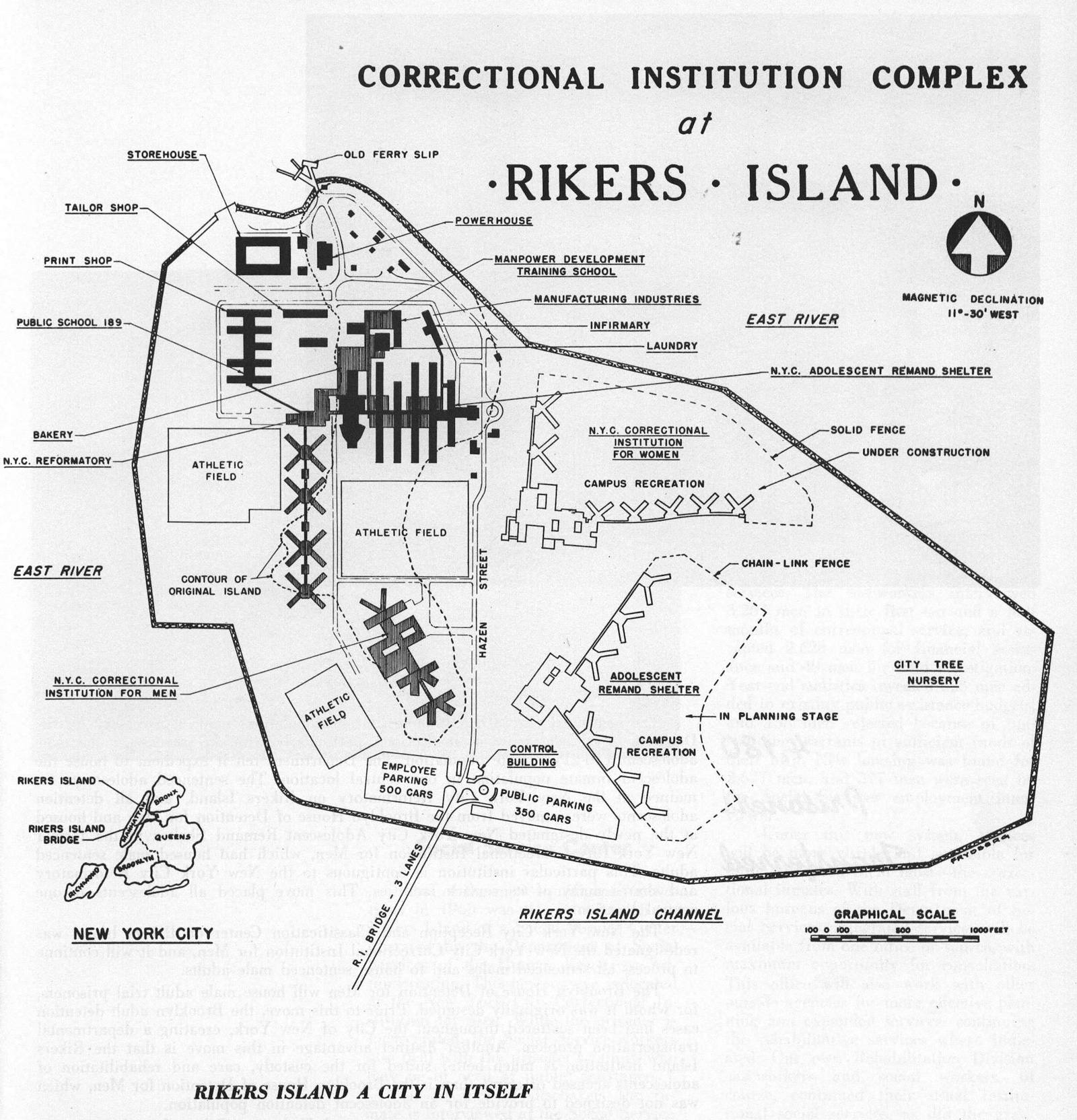
New York City Department of Correction/Urban Omnibus
Plans for Rikers Island as “a city in itself,” projected five separate institutions for men, women, and adolescents, with a total capacity of 6,780 people. The plan’s caption promised “natural island security,” centralized facilities and staff, and “centralized control of employees and visitors to the island,” from the DOC Annual Report, 1966
And yet, once the jails or prisons are built, the reformers lose control of operations. One of the institutional reasons for that, Shanahan says, is the correction officers’ union. “The defining political issue of the New York City jail system since 1960 has been the political power held by guards,” he said. The Correction Officers’ Benevolent Association (COBA) has been very effective at blocking accountability for abusive or violent behavior. COBA’s current president, Elias Husamudeen, argues that his members are the ones who are in need of protection from violent inmates.
Because the mayor’s blueprint does nothing to address COBA members’ de facto immunity, people like Shanahan, and Encalada-Malinowski of VOCAL, are skeptical of the plan, questioning why we’d expect change in new jails from an unaccountable agency with no transparency. “In what other city agency can people just die and there not be any inquiry as to whether or not there needs to be a leadership change at that agency?” Encalada-Malinowski asked.
The city’s inability to manage the very agency that oversees prisons doesn’t inspire confidence, and threatens to undermine any progress that would come from the new plan. Even with the injection of resources, programming, and retraining over the last couple of years—part of the city’s fourteen-point plan to combat the culture of violence in its jails—the Department of Correction remains troubled. While the incarcerated population has fallen sharply, the department’s budget continues to increase; as a result, it has gone on the City Comptroller’s Agency Watch List for a second year in a row. The department has a staff of around 10,000 people overseeing some 7,000 inmates (by comparison, the entire Federal Bureau of Prisons has a staff of about 36,000 for its 177,000 inmates).
In 2015, the City’s Department of Investigation revealed a corrupt process of recruiting in the agency, including the hiring of people with prior gang associations. The seventh independent federal monitor of the Department of Correction has said that in the last six months, “the department’s use of force rates reached their highest levels” since monitoring begun. The New York State Commission of Correction has, in its time overseeing Rikers, witnessed “extensive and systemic non-compliance” with regulations and the department’s “unwillingness and inability to take required actions to remedy” the deplorable situation.
Eisenberg-Guyot argued that such abuses are baked in—“the ultimate endpoint of all jail and prison construction: conditions degrade because the dehumanization and violence is the point.” Abolitionists also raise grave doubts about the mayor’s plan to build a number of “therapeutic housing units,” in addition to the four jails, for the mentally ill—to be run by the Department of Correction—rather than diverting people into mental health institutions. Mack, who was holding a sign that read “Dump DOC” at the land use review hearing, advocates redirecting most of the funds from the agency into community resources such as public health and housing. Studies have shown that the majority of New Yorkers in jails and prisons come from seven neighborhoods. If the city wants to address problems at their roots, it has the information to do so. Dana Kaplan, the deputy director of Close Rikers and Criminal Justice Initiatives at the mayor’s office, told me that she “fully appreciates the call to invest in other community-based diversion programs,” but doesn’t see it as mutually exclusive with the current plan for borough jails. Here was the fundamental divergence laid bare: activists distrust the system, and see investment in people as a way to make it obsolete. The city distrusts the people and sees investment in the system as a way to keep them in check.
In her 2003 book Are Prisons Obsolete?, the veteran activist Angela Davis writes that one of the paradoxes of prisons is that while most people can’t imagine life without them, “there is reluctance to face the realities hidden within them, a fear of thinking about what happens inside them. Thus, the prison is present in our lives and, at the same time, it is absent from our lives.” This is slowing changing—and prisoners, too, have forced their way into public consciousness, most memorably in 2016 on the forty-fifth anniversary of the Attica uprising when work stoppages and strikes occurred simultaneously across the country in the biggest prison strike in American history. Closer to home, when 1,600 inmates were left to freeze in the federal Metropolitan Detention Complex in Sunset Park when power and heat were out for weeks this past winter, inmates protested by banging on the windows, catching the attention of people outside and turning the conditions into a scandal.
One of those who joined protests outside the MDC was Kevin Steele, an activist who helps organize prison strikes through the Incarcerated Workers Organizing Committee. He joined the No New Jails protestors. Steele, who spent time at Rikers himself—and got to know Browder—including a year in solitary, believes more of the formerly incarcerated should be telling their stories to convey to the public the true crisis of mass incarceration. Inspired by reading the book version of the musical Hamilton, Steele wrote a Hip Hopera, Taliaferro, that was peformed at Eastern Correctional Facility, for Black History month, “about the beef between [Booker T.] Washington and [W.E.B.] Dubois. It was dope. We got all these men singing and rapping.”
A couple weeks ago, I took the ferry up to the Bronx neighborhood of Soundview to meet with Steele. He is currently working on a film, and developing a curriculum for schools and students to start more complex conversations about prisoners. What bothers him the most, he said, was the insidious way the culture of violence at a place like Rikers follows people home. Many of the correction officers and police inside prisons are also low-income, working-class people from these same neighborhoods as the incarcerated, he explained. But tensions arise from their roles and relationships in the system. Steele said he feels lucky that he was mostly able to resist internalizing the violence. “I’m a little messed up. I think everyone is dealing with that.”
*
The City Council will vote on the mayor’s plan later this month. The Council usually votes in line with the members whose district the land use application affects—and all four seemed positive about the mayor’s plan at the September 5 hearing, so the scheme seems likely to move forward. Almost all the activist groups are demanding more changes to the plan as it stands, however, while tensions remain between those who believe it is a necessary evil to achieve the closure of Rikers and those who think Rikers can be closed with a better plan. Two weeks ago, the president of the Ford Foundation and a member of the Lippman Commission warned against taking an “extreme” position in the Rikers debate and letting “the perfect be the enemy of progress.” Four days later, speaking at Riverside Church, Angela Davis encouraged activists to show up outside the Ford Foundation building in protest, arguing that abolitionism is not an extreme position. Members of grassroots organizations like Decolonize This Place, Take Back the Bronx, and No New Jails showed up to the protest outside the foundation and about 300 current and former Ford Foundation fellows signed a letter in defense of abolitionism as a reasonable aim.
At the council hearing, Brooklyn Councilmember Stephen Levin, whose district would house the new Brooklyn jail, asked Elizabeth Glazer, the director of the Mayor’s Office of Criminal Justice, “if money wasn’t an object and we could implement every type of criminal justice reform measure to the maximum scale, what would we want to do?” Glazer listed implementing diversion programs, doing away with city sentences, funding alternatives to incarceration, and supporting early interventions to prevent people from coming into contact with the criminal justice system—“a ton of things that could be done to ensure that jails aren’t a first stop.”
Listening to her speak reminded me of reading de Blasio’s 2016 comment that the closure of Rikers was “unrealistic,” and made me think how little had truly changed since. It fell to the abolitionist Mariame Kaba to warn of the cost of failing to realize what’s possible: “We will be back in this room, I promise you, in ten years, if these four new facilities are built, calling these facilities inhumane.”


